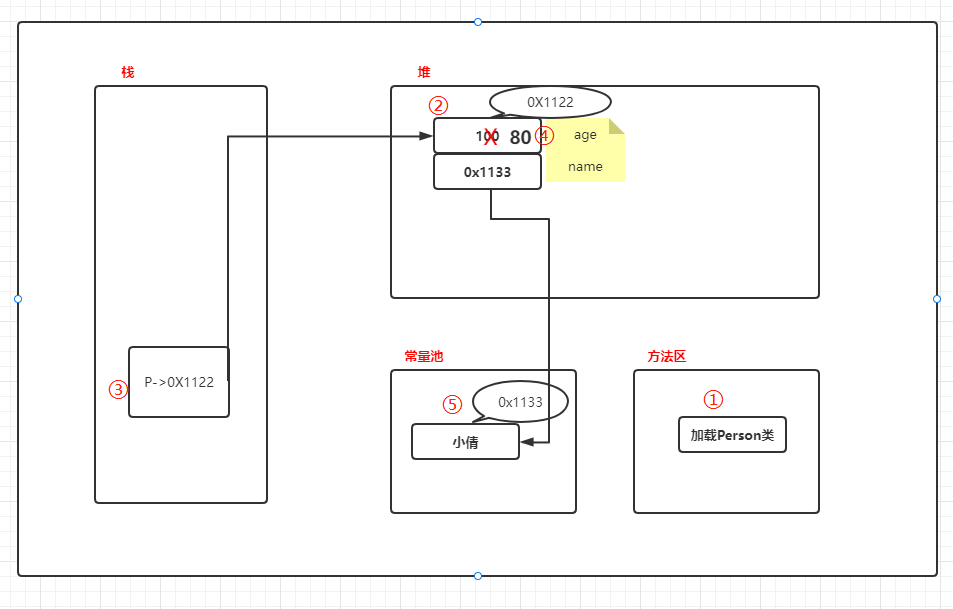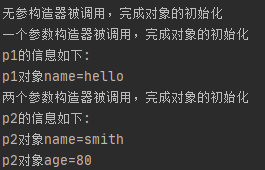1. Constructor overview
(1) Introduction to constructor
- Constructor: it is a special method of class to complete the initialization of new objects;
//Constructor definition method
[Modifier ] Method name(parameter list ){
Method body;
}
(2) Constructor considerations
① The modifier of the constructor can be default or public, protected or private;
② Constructor has no return value;
③ Method name and class name must be the same;
④ The parameter list has the same rules as the member method;
⑤ The constructor is called by the system – when creating an object, the system will automatically call the constructor of this class to complete the initialization of the object;
⑥ A class can define multiple different constructors, that is, constructor overloading;
⑦ If no constructor is specified during development, the system will automatically generate a default parameterless constructor for the class;
⑧ The default constructor cannot be used unless the constructor is defined by itself;
- example
public class hello {
public static void main(String[] args) {
//When we create an object in new, we specify the name and age directly through the constructor
Person p0 = new Person();
Person p1 = new Person("hello");
System.out.println("p1 The information is as follows:");
System.out.println("p1 object name=" + p1.name);
Person p2 = new Person("smith",80);
System.out.println("p2 The information is as follows:");
System.out.println("p2 object name=" + p2.name);
System.out.println("p2 object age=" + p2.age);
}
}
class Person{
String name;
int age;
//constructor
//1. The constructor has no return value and cannot write viod
//2. The constructor has the same name as the class Person
//3. (String pName,int pAge) is a list of constructor formal parameters. The rules are the same as member methods
public Person(){
System.out.println("The parameterless constructor is called to complete the initialization of the object");
}
public Person(String pName){
System.out.println("A parameter constructor is called to complete the initialization of the object");
name = pName;
}
public Person(String pName,int pAge){
System.out.println("Two parameter constructors are called to complete the initialization of the object");
name = pName;
age = pAge;
}
}
- Operation results

2. Constructor memory parsing (object creation)
- example
public class hello {
public static void main(String[] args) {
//When we create an object in new, we specify the name and age directly through the constructor
Person p2 = new Person("Xiao Qian",80);
System.out.println("p2 The information is as follows:");
System.out.println("p2 object name=" + p2.name);
System.out.println("p2 object age=" + p2.age);
}
}
class Person{
String name;
int age=100;
public Person(String pName,int pAge){
System.out.println("Two parameter constructors are called to complete the initialization of the object");
name = pName;
age = pAge;
}
}
- Operation results

- Memory parsing

Step 1: load the person class (Person.class) in the method area, which will only be loaded once;
The second step is to allocate space (address) in the heap;
Step 3: initialize the attribute by default (age = 0,name = null);
Step 4 and then explicitly initialize the attribute (age = 90)
Step 5: finally, the constructor initializes the attribute (name = ox1133). Ox1133 is the address of smith in the constant pool;
Step 6: return the heap space address to P, where p is the reference of the object;
3. this keyword
-
Meaning: java virtual opportunity assigns this to each object to represent the current object.
-
Function: the constructor directly uses attributes as formal parameters
-
example
public class hello {
public static void main(String[] args) {
//When we create an object in new, we specify the name and age directly through the constructor
Person p0 = new Person();
Person p1 = new Person("hello");
System.out.println("p1 The information is as follows:");
System.out.println("p1 object name=" + p1.name);
Person p2 = new Person("smith",80);
System.out.println("p2 The information is as follows:");
System.out.println("p2 object name=" + p2.name);
System.out.println("p2 object age=" + p2.age);
}
}
class Person{
String name;
int age;
//constructor
//1. The constructor has no return value and cannot write viod
//2. The constructor has the same name as the class Person
//3. (String pName,int pAge) is a list of constructor formal parameters. The rules are the same as member methods
public Person(){
System.out.println("The parameterless constructor is called to complete the initialization of the object");
}
public Person(String name){
System.out.println("A parameter constructor is called to complete the initialization of the object");
this.name = name;
}
public Person(String name,int age){
System.out.println("Two parameter constructors are called to complete the initialization of the object");
this.name = name;
this.age = age;
}
}
- Operation results

- matters needing attention
(1) This keyword can access the properties, methods and constructors of this class;
Ⅰ,Attribute access syntax:this.Attribute name Ⅱ,Member method access syntax:this.Method name(parameter list) Ⅲ,Constructor access syntax:this(constructor )
(2) this is used to distinguish the attributes and local variables of the current class;
(3) this cannot be used outside the class definition, but only in the method defined by the class
4. Access modifier
- Function: control the modification scope of methods and attributes
| Serial number | Access level | Access modifier | similar | Same package | Subclass | Different packages |
|---|---|---|---|---|---|---|
| 1 | open | public | √ | √ | √ | √ |
| 2 | under protection | protected | √ | √ | √ | |
| 3 | default | No modifier | √ | √ | ||
| 4 | private | private | √ |
- Precautions for use
1. Modifiers can modify attributes, member methods and classes in a class;
2. Only default and public can modify classes, and follow the above access rights principles;
3. The access rules of member methods are the same as those of properties